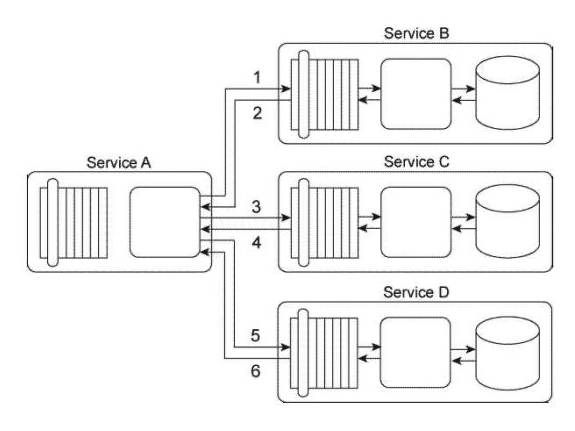Service A is a task service that is required to carry out a series of updates to a set of databases in order to complete a task. To perform the database updates Service A must interact with three other services, each of which provides standardized data access capabilities. Service A sends its first update request message to Service B (1) , which then responds with a message containing a success or failure code (2) . Service A then sends its second update request message to Service C (3) , which also responds with a message containing a success or failure code (4) . Finally, Service A sends a request message to Service D (5) , which responds with its own message containing a success or failure code (6) .  You've been given a requirement that all database updates must either be completed successfully or not at all. This means that if any of the three response messages received by Service A contain a failure code, all of the updates carried out until that point must be reversed. Note that if Service A does not receive a response message back from Services B, C, or D, it must assume that a failure has occurred. How can this service composition architecture be changed to fulfill these requirements?
You've been given a requirement that all database updates must either be completed successfully or not at all. This means that if any of the three response messages received by Service A contain a failure code, all of the updates carried out until that point must be reversed. Note that if Service A does not receive a response message back from Services B, C, or D, it must assume that a failure has occurred. How can this service composition architecture be changed to fulfill these requirements?
A) The Reliable Messaging pattern can be applied to guarantee the delivery of positive or negative acknowledgements. This way, Service A will always be informed of whether a failure condition has occurred with any of the database updates performed by Services B, C, and D. Furthermore, the Service Loose Coupling principle can be applied to ensure that the request and response messages exchanged by the services do not contain any implementation details that would indirectly couple Service A to any of the databases.
B) The Atomic Service Transaction pattern can be applied individually to Services B, C, and D so that each of these services performs its own database update within the scope of an atomic transaction. If anyone update fails, that change can be rolled back on that database. Furthermore, the Service Loose Coupling principle can be applied to ensure that Service A is kept out of the scope of the atomic transaction so that it is not negatively coupled to the proprietary database technologies that are required to enable the atomic transaction functionality.
C) The Compensating Service Transaction can be applied to Service A so that when any one response message containing a failure code is received by Service A, it can invoke exception handling logic that will log the failed database updates. The Service Loose Coupling principle can be further applied to ensure that Services B, C, or D are not indirectly coupled to the exception handling logic, especially if Service A requires additional access to Services B, C, or D in order to collect more information for logging purposes.
D) None of the above.
Correct Answer:
Verified
Q10: You are told that in this service
Q11: Service A is a utility service that
Q12: Service A is a task service that
Q13: When Service A receives a message from
Q14: Service A is a utility service that
Q16: Service A is an entity service that
Q17: Services A, B, and C are non-agnostic
Q18: Service A is a task service that
Q19: Service Consumer A sends a message to
Q20: Service Consumer A sends a message to
Unlock this Answer For Free Now!
View this answer and more for free by performing one of the following actions

Scan the QR code to install the App and get 2 free unlocks

Unlock quizzes for free by uploading documents